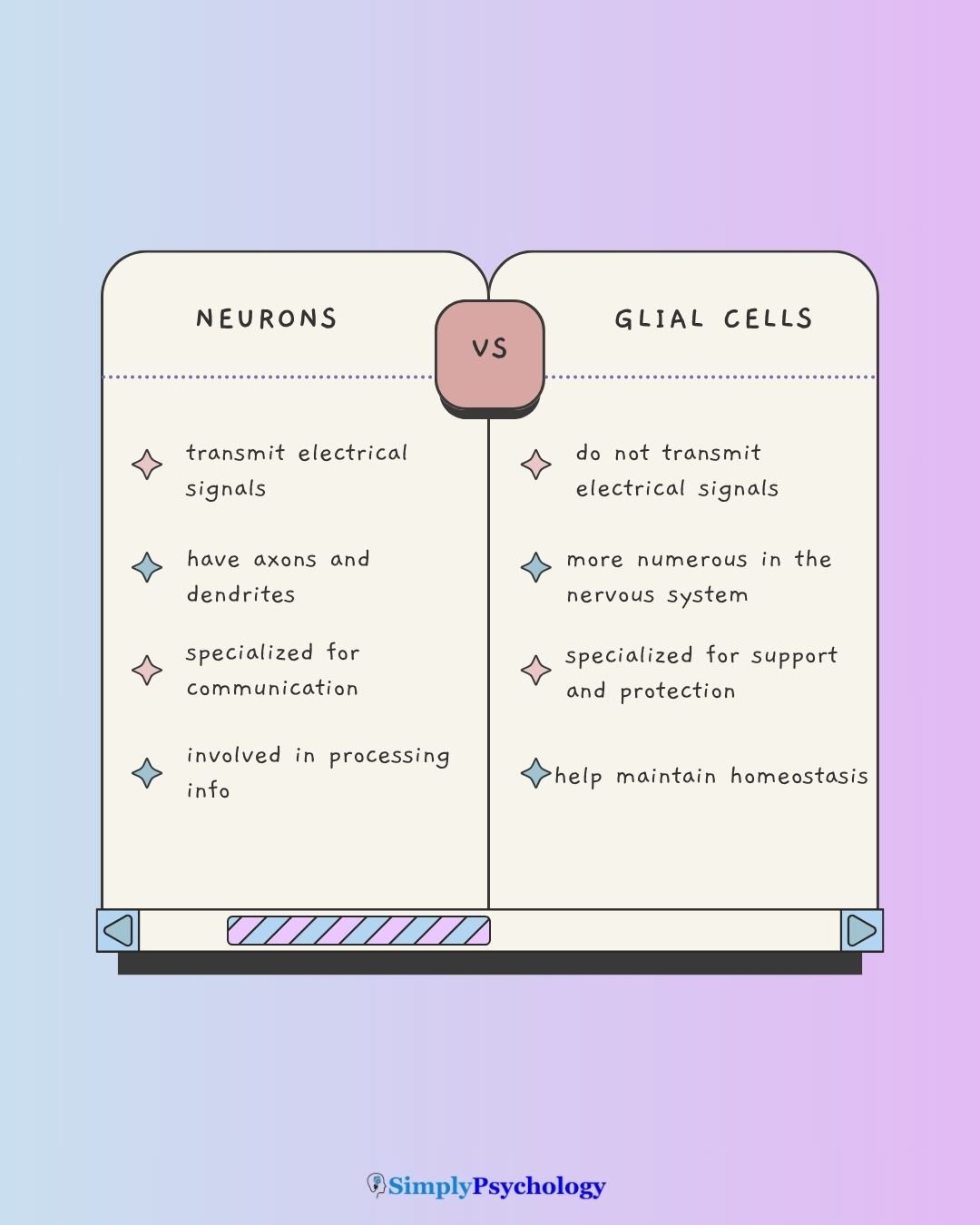Neurons and glial cells are the two main types of cells in the nervous system, and understanding how they differ is essential for studying brain function and behavior.
While neurons are widely known for transmitting electrical and chemical signals, glial cells play equally vital roles in supporting, protecting, and regulating those neurons.
Grasping the distinct roles of these cells helps build a deeper understanding of how thoughts, emotions, and disorders arise from complex cellular interactions in the brain.

Key Takeaways
- Neurons transmit electrical signals and are responsible for thought, memory, and emotion.
- Glial cells do not transmit signals, but support, nourish, and protect neurons in many vital ways.
- Neurons have axons and dendrites for communication, while glial cells typically lack these structures.
- Glial cells include types like astrocytes, oligodendrocytes, and microglia, each with specialized roles such as forming myelin or defending against infection.
- Neurons and glial cells work together, and problems in either can contribute to neurological and psychological disorders like MS or schizophrenia.
What Are Neurons and Glial Cells?
Neurons and glial cells are the two primary types of cells that make up the nervous system.
The nervous system itself is the body’s intricate communication network, a complex system of channels that carry electrochemical signals throughout the body.
Neurons, also known as nerve cells, are considered the fundamental building blocks and interconnected information processors of this system.
They are essential for all nervous system tasks, including thought, memory, and emotion, as they react to stimuli, conduct impulses, and emit chemical regulators.
Glial cells, or neuroglia, serve as vital support cells for neurons. They perform crucial functions such as providing physical scaffolding, nourishment, insulation for neuronal communication, removing waste products, and protecting neurons from harmful substances.
Both neurons and glial cells are essential components of the nervous system, but they fulfil different, complementary roles.
Key Differences Between Neurons and Glial Cells
While both are indispensable, they serve distinct and complementary roles within this complex system.
Here are the key differences between them:
Neurons:
- Structure: Neurons possess specialized components for communication, including branching dendrites that act as input sites to receive signals. A single, long axon serves as the output, transmitting signals away from the cell body, typically ending in terminal buttons where messages are released.
- Function: They are the interconnected information processors essential for all nervous system tasks, reacting to stimuli, conducting impulses, and emitting chemical regulators necessary for thought, memory, and emotion.
- Signal Transmission: Neurons communicate through electrochemical events. An electrical impulse, called an action potential, travels rapidly down the axon. Upon reaching the terminal, this electrical message converts into a chemical message (neurotransmitters) released into the synaptic cleft to bind with adjacent neurons.
Glial Cells:
- Structure: Unlike neurons, glial cells generally lack axons and dendrites. They are primarily support cells rather than signaling units.
- Function: Glial cells perform crucial supportive functions for neurons. This includes providing physical scaffolding for the nervous system, offering nourishment, insulating neurons by forming the myelin sheath (which increases signal speed), removing waste products, and protecting neurons from harmful substances. They also help neurons align for efficient communication and mediate immune responses.
- Signal Transmission: Glial cells do not directly transmit electrochemical signals or communicate via neurotransmitters between neurons. Their role is to facilitate and maintain the environment for neuronal communication.
This distinction highlights how their specialized structures enable their unique yet complementary roles in the nervous system.
How do neurons and glial cells work together?
Neurons, the brain’s information processors, fundamentally rely on glial cells for optimal function. Glia provide physical support, nourish neurons, and remove waste products, creating the ideal environment for communication within the nervous system.
Their interaction is crucial for cognition and behavior; for example, glial cells form the myelin sheath, insulating axons and vastly increasing the speed of neural signal transmission, which is vital for efficient thought and action.
This close neuron-glia communication extends to supporting brain development and neuroplasticity, allowing the nervous system to adapt and form new connections.
Dysfunctions in this partnership have significant implications for understanding disorders. In Multiple Sclerosis (MS), the widespread loss of the myelin sheath directly impedes rapid information transfer by neurons, leading to severe symptoms.
For Schizophrenia, while complex, research indicates changes in brain anatomy, including reduced overall brain volume and gray matter in frontal lobes, highlighting that compromised cellular architecture, including glial support, can underpin such disorders.
Their combined, complementary roles are essential for all nervous system functions.
Types of neurons
Below are the types of neurons:
- Sensory (Afferent) Neurons: These neurons transmit information from the body’s periphery, such as sensory input, towards the central nervous system (CNS) and the brain.
- Motor (Efferent) Neurons: These communicate information in the opposite direction, from the brain and nervous system to muscles and glands, allowing for responses.
Types of glial cells
Below are some of the types of glial cells:
- Astrocytes: Maintain the chemical environment, support neurons structurally, and help form the blood-brain barrier.
- Oligodendrocytes: Produce the myelin sheath that insulates axons in the central nervous system (CNS).
- Schwann Cells: Create the myelin sheath around axons in the peripheral nervous system (PNS).
- Microglia: Act as immune cells in the CNS, clearing debris and responding to injury or infection.
- Ependymal Cells: Line the brain’s ventricles and help circulate cerebrospinal fluid (CSF).

